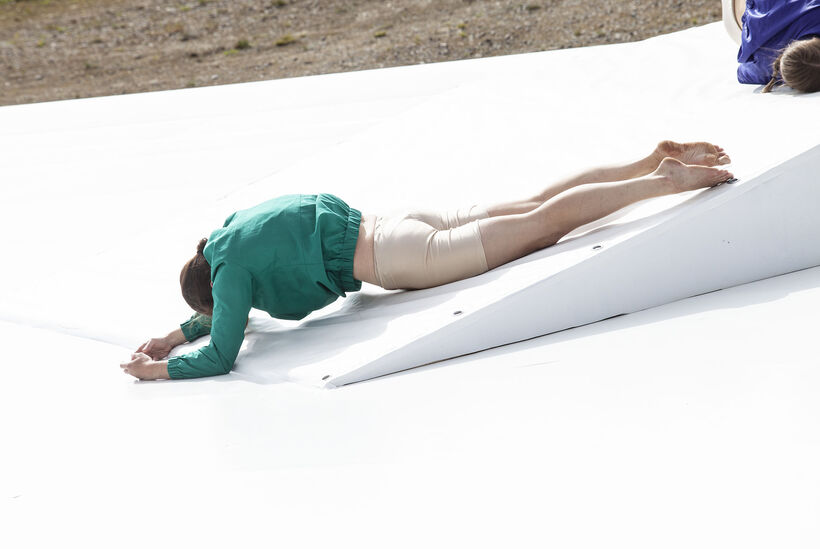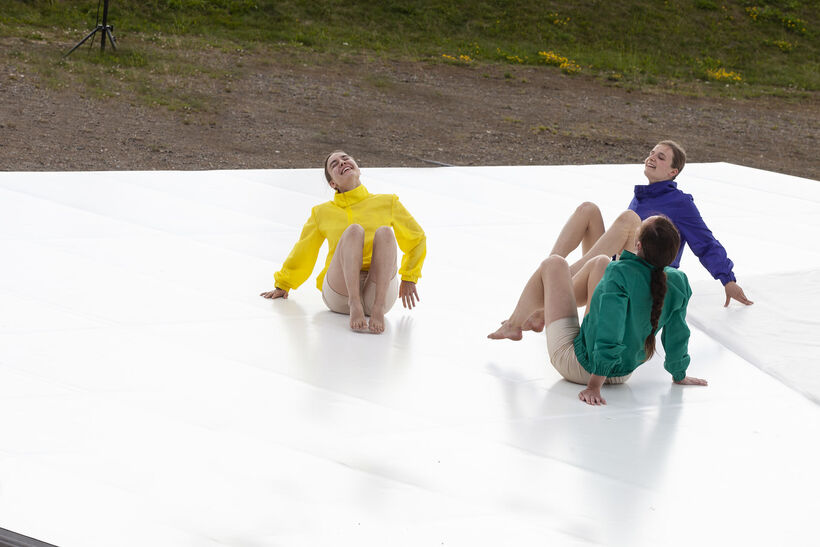The body confirms: you are here. The mind wants to travel
The body gives simplicity, resistance, or surprise. The mind enables understanding, confusion, or poetry. The emotional responses appear on the way through triggers and memories. Interacting or choreographing evokes all of these parts together. Suddenly, I'm impressed by the complexity of human beings/bodies performing.
Writing brings into focus.
I'm recalling the festival KoresponDance taking place at Žďár nad Sázavou in mid-July 2022, and the time spent in a dynamic dramaturgy of encounters. In a festival setting, there are always messy experiences. Curiosity selects the adventures, and distractions interrupt the flow and surprise. The mind wants to – and the body needs to – move, or the other way around. Participation at the festival inspired me to address the challenges of encounters. The encounters that feed kinaesthetic empathy exist in feedback loops between bodies, minds, and spaces. Therefore, this text is an invitation to observe the choreography between physicality and expression, spectator and performer, and inner and outer space. It encourages looking through the body as an experiment, to trace the elemental urge for reciprocal affects.
We share various presences.
We come together in the green surroundings, waiting for Galit Liss's performance I'M HERE 1. Through the gates of Žďár castle, one of the festival's sites, performers approach us from afar. They take off their shoes. I take off my shoes. Maybe I could feel the ground better. We hear recorded instructions preparing us for attentiveness. Mutual observation begins, and tenderness immediately spreads across the stage. The image of numerous mature women and non-dancers bravely embarking on body research triggered an emotional reaction in me. I wonder who among the audience feels similarly touched? Spontaneously, I maintain eye contact with one performer.
The focus sharpens.
I can only see her eyes, and feel uneasiness traveling through my chest. Prolonged eye contact is always intriguing and uncomfortable at the same time. I choose to stay with the discomfort. The performer smiles with her eyes, and the body relaxes.
Several performers dance with obvious enjoyment.
My spine follows them with a gentle sway. Movements that surprise the body bring exceptional pleasure. I wonder where such movements originate. In the body, the affect – or the synchronization of the two? They seem unencumbered with analysis, and bring a childlike playfulness. The performers continue to dance. I read some physical expressions as shy, some as very present, and some as freeing joy in movement and exposure. These are the inner states and movement qualities revealed by the improvisation. It feels like we are all immersed in the scene.
I sense the attention behind me.
Looking at amateur performers evokes a glimpse of a specific empathy. It reminds me of the beginnings of my dance training, of the raw quality of an unelaborated range of movement. I imagine how the dance becomes closer to those observers without a developed dance technique, nor the sensations that belong to the trained body.
Simplicity is refreshing.
The audience is quickly involved in a small experiment of non-verbal conversation. The hands of the performers invite and move the hands of the observers. One-on-one. Hands are mimicking each other, resting in the encounter.
While the hands represent an essential element of closeness in I'M HERE 1, hands announce the estranged performers in Or to Be, by Markéta Stránská and Jean Gaudin. This time, we are not directly interacting with the performers. We are squeezed to one side of the castle's room in an elongated oval shape. There were too many of us in the audience, as the festival team was kind enough to include all interested observers.
The two performers are alternating in the space bringing emotionally-charged atmospheres from their enclosed worlds. Fragmented movements in front of us bring a restlessness to my observing body.
Confused looks from the audience.
A loud and almost terrifying laughter echoes through the room. It forms a nervous sheath around me. A hand appears behind one of the three doors of the performance room. Attention shifts from large to close-up frames, as if we were in a movie scene. The rest of the body follows the hand.
Tiny nervous steps cover the floor.
The performer approaches almost a meter from me – together with a few members of the audience, with whom I share the close encounter. He exhales. How much space does exhalation occupy? Is it too close to us? The mouth opens, as if the words want to be spoken. Out of habit for verbal comprehension, I try to recognize words by reading lips. They remain as unarticulated lip movements. Trembling and shaking hands feels inspiring and liberating – like a child, or a person who does not worry about the eyes of society's conventions. Spontaneous jerks are in my shoulders.
Energy must be released.
The sound of paper cuts the space, and fills the stage. The performer pushes it, and then surrenders to the material. It feels like the tension transfers from the body to the paper, from paper to sound, and from sound to the audience. Still squeezed and in an uncomfortable standing position, I feel drawn and confused by the surreal atmosphere of the choreography.
The two performers never encounter.
They are circulating through the rooms, self-absorbed. A sense of alienation follows the whole performance. That would perhaps explain the nervous reactions I caught on the faces of the observers. The performers seem almost trapped in their minds/movements, and we don't have full access to them.
A similar denial of access occurs in Treatment of Remembering by POCKETART, where we are witnessing another world from a distance of our seats.
The sounds and dancers immediately pull me into it. Their closed eyes encourage my inward focus. I imagine the inside of the skin – mine, theirs. The actions, postures, and organic synchronicity between the dancers remove the human quality of movement. How much of the body is not human?
Hands tremble, mouths open – a silent scream.
I feel it in the jaw – the tension of a limit reached. Muscle tension in the hands, opening to the space above. I rarely open my hands upwards. It reminds me of the feeling of surrendering to movement, landscape, or the moment. I feel the urge to try that liberating movement. It is liberating not to move like a human – or at times not to be one. To move like an object, plant, animal, part of the landscape, atmosphere – or not to move at all. It could be an exercise in empathy toward non-humans, through imaginary embodiments. The choreography absorbs the dancers. They are synchronised, but persist in individual rhythms and states.
Twitching, trembling, shaking.
It's as if we are meditating with the performers on a necessary difficulty that precedes the attunement. A recording of whispering travels through the skin, provoking goosebumps. The words seem to be close to the ears. I do not understand the language, so the spoken words remain only an intense physical experience. The atmosphere is otherworldly, apocalyptic, and a little scary. We witness what I interpret as the consequences of the destruction of nature, revealing the remaining creatures of unknown identity. We are all in silence, and observing, very still, I move through internal tensions.
Moving is encountering is affecting.
Surrounded by the festival's picturesque landscape in an experimental social setting, affects have space to be noticed and practiced. The bodies of performers and audiences seek experiences that inspire, rest, and energise – or even seek each other. The three performances described encouraged me to observe the body: through simple eye contact or moving hands; estranged movements in the lack of connection; or the imagination of the non-human world. These body events seem like a present from the performers, to get to know ourselves again, in multisensory ways. Perhaps our deepest desire is for encounters to transform us. To open what is closed, and become a collective body, affecting and resonating.
Editorial note: This text is written as part of an international writing workshop entitled Writing About Dance (On Body And Mobility). The workshop was a collaboration between Taneční aktuality and Performing Criticism Globally, kindly supported by EEA Grants, and the resulting texts were written in response to productions at this festival.





